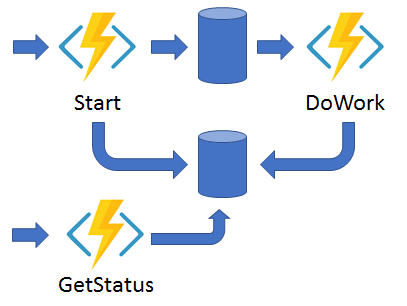csharp Azure功能
Posted
tags:
篇首语:本文由小常识网(cha138.com)小编为大家整理,主要介绍了csharp Azure功能相关的知识,希望对你有一定的参考价值。
# Key Configuration Files
## Local Settings
The file `local.settings.json` stores app settings, connection strings, and settings used by local development tools.
These should be the same as the application settings in the function app in Azure.
If you have created application settings in Azure, you can download them into your local settings file.
Because it contains secrets it never gets published, and is excluded from source control.
## Host
The `host.json` metadata file contains global configuration options that affect all functions for a function app.
```json
{
"version": "2.0"
}
```
These settings apply both when running locally and in Azure.
See [here](https://docs.microsoft.com/en-us/azure/azure-functions/functions-host-json) for more.
Can include settings for extensions, health monitoring and logging for example.
## Bindings - `function.json`
In a C# class library project, the bindings are defined as binding attributes
on the function method. The `function.json` file is then autogenerated based
on these attributes:
```json
{
"generatedBy": "Microsoft.NET.Sdk.Functions-1.0.29",
"configurationSource": "attributes",
"bindings": [
{
"type": "httpTrigger",
"methods": ["get", "post"],
"authLevel": "function",
"name": "req"
}
],
"disabled": false,
"scriptFile": "../bin/functions.dll",
"entryPoint": "My.Functions.HttpTriggerCSharp.Run"
}
```// HTTP trigger, with Storage Queue o/p
[FunctionName("HttpTriggerQueueOutput")]
public static async Task<IActionResult> Run(
[HttpTrigger(AuthorizationLevel.Function, "get", "post", Route = null)] HttpRequest req,
[Queue("outqueue"), StorageAccount("AzureWebJobsStorage")] ICollector<string> msg, ILogger log)
{
log.LogInformation("C# HTTP trigger function processed a request.");
// Add a message to the output collection.
msg.Add(string.Format("Name passed to the function: {0}", name));
}
// Queue trigger, Table o/p
[FunctionName("QueueTriggerTableOutput")]
[return: Table("outTable", Connection = "MY_TABLE_STORAGE_ACCT_APP_SETTING")]
public static Person Run(
[QueueTrigger("myqueue-items", Connection = "MY_STORAGE_ACCT_APP_SETTING")] JObject order,
ILogger log)
{
return new Person() {
PartitionKey = "Orders",
RowKey = Guid.NewGuid().ToString(),
Name = order["Name"].ToString(),
MobileNumber = order["MobileNumber"].ToString()
};
}
// Blob trigger
[FunctionName("BlobTrigger")]
public static void Run([BlobTrigger("samples-workitems/{name}")] Stream myBlob, string name, ILogger log)
{
log.LogInformation($"C# Blob trigger function Processed blob\n Name:{name} \n Size: {myBlob.Length} Bytes");
}
// CosmosDB trigger
[FunctionName("CosmosTrigger")]
public static void Run(
[CosmosDBTrigger(
databaseName: "ToDoItems",
collectionName: "Items",
ConnectionStringSetting = "CosmosDBConnection",
LeaseCollectionName = "leases",
CreateLeaseCollectionIfNotExists = true)
] IReadOnlyList<Document> documents,
ILogger log)
{
if (documents != null && documents.Count > 0)
{
log.LogInformation($"Documents modified: {documents.Count}");
log.LogInformation($"First document Id: {documents[0].Id}");
}
}# Chaining

# Fan out / fan in

# Async HTTP APIs

See [Create your first durable function in C#](https://docs.microsoft.com/en-us/azure/azure-functions/durable/durable-functions-create-first-csharp).
# Monitor

# Human interaction

# Aggregator (preview)
// Durable function chaining
public static async Task<object> Run(DurableOrchestrationContext context)
{
try
{
var x = await context.CallActivityAsync<object>("F1");
var y = await context.CallActivityAsync<object>("F2", x);
var z = await context.CallActivityAsync<object>("F3", y);
return await context.CallActivityAsync<object>("F4", z);
}
catch (Exception)
{
// Error handling or compensation goes here.
}
}
// Fan out / fan in
public static async Task Run(DurableOrchestrationContext context)
{
var parallelTasks = new List<Task<int>>();
// Get a list of N work items to process in parallel.
object[] workBatch = await context.CallActivityAsync<object[]>("F1");
for (int i = 0; i < workBatch.Length; i++)
{
Task<int> task = context.CallActivityAsync<int>("F2", workBatch[i]);
parallelTasks.Add(task);
}
await Task.WhenAll(parallelTasks);
// Aggregate all N outputs and send the result to F3.
int sum = parallelTasks.Sum(t => t.Result);
await context.CallActivityAsync("F3", sum);
}
// Monitor - Not much of a clue what is going on here
// Human
public static async Task Run(DurableOrchestrationContext context)
{
await context.CallActivityAsync("RequestApproval");
using (var timeoutCts = new CancellationTokenSource())
{
DateTime dueTime = context.CurrentUtcDateTime.AddHours(72);
// create the durable timer
Task durableTimeout = context.CreateTimer(dueTime, timeoutCts.Token);
// wait for approval
Task<bool> approvalEvent = context.WaitForExternalEvent<bool>("ApprovalEvent");
// check approval
if (approvalEvent == await Task.WhenAny(approvalEvent, durableTimeout))
{
timeoutCts.Cancel();
await context.CallActivityAsync("ProcessApproval", approvalEvent.Result);
}
else
{
await context.CallActivityAsync("Escalate");
}
}
}
// Aggregator
// Using a Durable Entity function, one can implement this pattern easily as a single function.
[FunctionName("Counter")]
public static void Counter([EntityTrigger] IDurableEntityContext ctx)
{
int currentValue = ctx.GetState<int>();
switch (ctx.OperationName.ToLowerInvariant())
{
case "add":
int amount = ctx.GetInput<int>();
currentValue += operand;
break;
case "reset":
currentValue = 0;
break;
case "get":
ctx.Return(currentValue);
break;
}
ctx.SetState(currentValue);
}
// yeah, not really sure what's going on here以上是关于csharp Azure功能的主要内容,如果未能解决你的问题,请参考以下文章